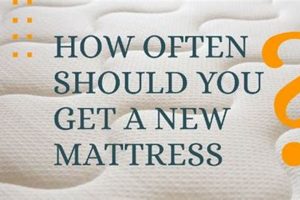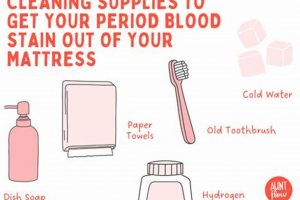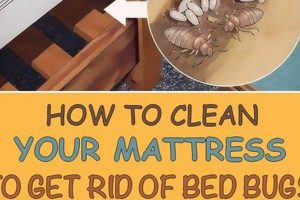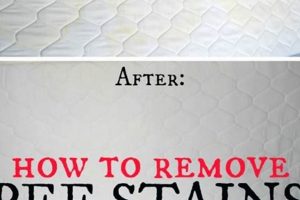The subject at hand involves eliminating a specific pest infestation from a sleeping surface. Effective methods often necessitate a multi-pronged approach, encompassing thorough cleaning, targeted treatments, and preventative measures. The goal is to eradicate the insects and prevent their resurgence, thereby restoring a healthy and comfortable sleep environment. For example, successful eradication may involve vacuuming, heat treatment, and the application of appropriate insecticides.
Addressing this problem is crucial for maintaining hygiene and preventing health complications. Bed bug infestations can lead to skin irritation, allergic reactions, and psychological distress. Historically, controlling these pests has been a challenge, requiring vigilance and the use of various strategies, from traditional remedies to modern pest control techniques. The consequences of ignoring the problem range from discomfort to the potential spread of the infestation to other areas.
This article will provide detailed guidance on identifying an infestation, preparing the affected area, and employing effective strategies to resolve the issue. It will also cover preventative measures to minimize the risk of future infestations. Following these steps carefully can contribute significantly to achieving and maintaining a pest-free sleeping environment.
Eradication Strategies
The following points outline essential steps in the process of eliminating bed bugs from mattresses. Success requires meticulous attention to detail and consistent application of the described methods.
Tip 1: Thorough Vacuuming: Initiate the process with a comprehensive vacuuming of the mattress surface, seams, and surrounding areas. Utilize a vacuum cleaner with a hose attachment and crevice tool to access tight spaces. Dispose of the vacuum bag or empty the canister immediately in a sealed bag outdoors to prevent re-infestation.
Tip 2: Mattress Encasement: Enclose the mattress in a certified bed bug-proof encasement. Ensure the encasement is tightly sealed and remains in place for at least one year to effectively trap and eliminate any remaining pests. This method prevents bed bugs from escaping and obtaining sustenance.
Tip 3: Heat Treatment Application: Subject the mattress to high heat using a specialized steamer. Direct the steam along seams, crevices, and folds. Ensure the temperature reaches a lethal level for bed bugs, typically above 120F (49C). Caution is advised to avoid damaging the mattress material with excessive heat.
Tip 4: Insecticide Application (With Caution): Consider using insecticides specifically labeled for bed bug control. Apply the product according to the manufacturer’s instructions, focusing on seams, tufts, and edges. Exercise extreme caution when using insecticides, ensuring proper ventilation and avoiding direct contact with skin or eyes.
Tip 5: Regular Inspection and Monitoring: Conduct regular inspections of the mattress and surrounding areas for signs of bed bug activity. Utilize interceptor traps placed under bed legs to monitor for new infestations. Early detection is crucial for preventing widespread infestations.
Tip 6: Professional Pest Control Consultation: If the infestation persists despite the implementation of the above methods, seek the assistance of a qualified pest control professional. Professionals possess the expertise and equipment to effectively eliminate severe or persistent infestations.
Consistent and diligent application of these strategies significantly enhances the likelihood of successfully eliminating bed bugs from mattresses, contributing to a healthier and more comfortable living environment.
These proactive measures, when implemented thoroughly, facilitate the transition towards a bed bug-free environment, supporting improved sleep quality and overall well-being.
1. Identification
Accurate identification is the cornerstone of effective bed bug eradication from mattresses. Without a clear understanding of the problem’s nature and extent, remediation efforts are likely to be misdirected, inefficient, and ultimately unsuccessful. This initial phase dictates subsequent strategies and resource allocation.
- Visual Confirmation of Bed Bugs
The primary step involves direct visual confirmation of bed bugs. Adult bed bugs are small, reddish-brown insects approximately the size of an apple seed. Nymphs, or young bed bugs, are smaller and lighter in color. Identifying these insects on the mattress, seams, or surrounding areas confirms their presence. Misidentification with other insects can lead to inappropriate treatment methods.
- Detection of Fecal Spots and Blood Stains
Even if live bed bugs are not immediately visible, evidence of their presence may be found in the form of small, dark fecal spots on the mattress, bedding, or nearby furniture. Similarly, small blood stains, resulting from bed bug bites, can indicate an infestation. Distinguishing these signs from other stains is essential for accurate assessment.
- Recognition of Bed Bug Odor
In cases of severe infestations, a distinct, musty odor may be noticeable. This odor is a result of pheromones released by bed bugs. While not always present, the odor can serve as an additional indicator of a significant infestation, guiding the scope of the eradication efforts.
- Understanding Bite Patterns and Symptoms
While bed bug bites alone are not definitive evidence, recognizing the typical bite patterns and associated symptoms can contribute to the identification process. Bed bug bites often appear as small, red, itchy welts, frequently occurring in clusters or lines. However, bite reactions can vary significantly among individuals, and other conditions can cause similar symptoms. Therefore, bite analysis should be considered in conjunction with other identification methods.
The information obtained during the identification phase directly informs the selection of appropriate eradication methods. A small, localized infestation may be addressed with targeted treatments, while a widespread infestation may necessitate more comprehensive measures, including professional pest control services. Accurate identification minimizes wasted effort and resources, ensuring that the chosen strategy is tailored to the specific characteristics of the infestation.
2. Preparation
The process of eliminating bed bugs from a mattress is significantly influenced by the preparatory measures undertaken. Adequate preparation directly impacts the efficacy of subsequent treatment strategies. A failure to properly prepare the environment may render even the most potent treatments ineffective, resulting in a prolonged or recurrent infestation. For example, neglecting to declutter the surrounding area can provide bed bugs with additional hiding places, shielding them from treatment. Conversely, thorough preparation maximizes the exposure of bed bugs to eradication methods, thereby increasing the likelihood of success.
Preparation involves several key steps. These include removing all bedding, linens, and clothing from the affected area, washing them in hot water and drying them on high heat to kill any potential bed bugs or eggs. Thorough vacuuming of the mattress, box spring, and surrounding areas is also essential to remove visible bed bugs and debris. Sealing cracks and crevices in walls and furniture near the bed can eliminate potential harborage sites. Properly preparing the mattress also includes the use of a mattress encasement to trap any existing bed bugs and prevent new ones from infesting the mattress. A real-world scenario might involve a homeowner meticulously following these preparation steps, followed by professional heat treatment. The success of the heat treatment hinges on the thoroughness of the initial preparation, as any overlooked hiding spots could lead to a re-infestation.
In summary, preparation constitutes a foundational element in resolving mattress bed bug infestations. Its importance lies in its direct influence on the effectiveness of treatment methods. Overlooking preparatory steps can significantly compromise the outcome, leading to wasted resources and continued infestation. By prioritizing thorough preparation, individuals can substantially enhance their chances of successfully eliminating bed bugs from their mattresses and preventing future occurrences.
3. Vacuuming
Vacuuming represents a crucial component in the comprehensive strategy designed to eliminate bed bugs from mattresses. Its effectiveness stems from the physical removal of bed bugs, their eggs, and fecal matter, thereby reducing the population and contamination levels. However, vacuuming alone is seldom sufficient for complete eradication and should be employed as part of a broader treatment plan.
- Physical Removal of Bed Bugs and Eggs
Vacuuming directly extracts bed bugs and their eggs from the mattress surface, seams, and crevices. This mechanical removal is particularly effective in areas where insecticides may not penetrate readily. For instance, using a crevice tool attachment, one can target areas along the mattress seams, where bed bugs often congregate and lay eggs. The immediate effect is a reduction in the active population and potential for further reproduction.
- Reduction of Allergen Load
Bed bug fecal matter and shed skins contribute to allergen buildup within the sleeping environment. Vacuuming removes these allergenic materials, thereby minimizing the risk of allergic reactions and respiratory irritation. Regular vacuuming of the mattress and surrounding areas is thus beneficial for both bed bug control and overall hygiene.
- Preparation for Subsequent Treatments
By removing surface debris and visible bed bugs, vacuuming enhances the efficacy of subsequent treatments, such as insecticide application or steam cleaning. A clean surface allows insecticides to penetrate more effectively and ensures that heat from steam treatments reaches bed bugs hidden within the mattress fibers. Skipping the vacuuming step can significantly reduce the effectiveness of these follow-up treatments.
- Importance of Proper Technique and Equipment
The effectiveness of vacuuming hinges on the use of appropriate equipment and techniques. A vacuum cleaner with strong suction and a HEPA filter is recommended to capture even the smallest bed bugs and eggs. It is critical to dispose of the vacuum bag or empty the canister immediately after use in a sealed bag outdoors to prevent re-infestation. Additionally, slow and deliberate movements with overlapping strokes ensure thorough coverage of the treated area. Rushing the vacuuming process or using inadequate equipment can lead to incomplete removal of bed bugs and eggs.
The facets of vacuuming, from physical removal to preparation for subsequent treatments, are intrinsically linked to the overall objective of eradicating bed bugs. While vacuuming provides a valuable initial step and supports other treatment methods, it is essential to recognize its limitations. As part of a holistic approach to “how to get bed bugs out of mattress,” vacuuming contributes significantly to reducing the infestation and creating a more favorable environment for successful eradication.
4. Encasement
Mattress encasement, specifically designed to be bed bug-proof, serves as a critical tool in the process of eliminating bed bugs from a mattress. The cause-and-effect relationship is clear: encasement prevents existing bed bugs within the mattress from escaping to feed, ultimately leading to their demise due to starvation, while simultaneously preventing new bed bugs from infesting the mattress. As a component of a bed bug eradication strategy, encasement offers a non-chemical approach to containment and control. Consider a scenario where a homeowner has treated a mattress with insecticides. Placing an encasement ensures that any surviving bed bugs remain isolated and are unable to re-infest the surrounding environment. This containment enhances the overall effectiveness of the treatment. The practical significance lies in its ability to protect both the mattress and the inhabitants from continued infestation.
Encasements are not merely protective covers; they represent a long-term management solution. Their use is particularly advantageous in multi-unit dwellings where bed bug infestations can easily spread between adjacent units. By encasing mattresses, the risk of transmission is substantially reduced. Furthermore, encasements facilitate easier inspection for bed bug activity. The smooth, light-colored surface of the encasement allows for straightforward visual detection of bed bugs or their fecal matter, enabling prompt intervention. The practical application extends to hotels and healthcare facilities, where the rapid turnover of occupants increases the risk of bed bug introduction. Regular encasement implementation in these settings provides a proactive measure against widespread infestations.
In summary, the application of mattress encasements is an integral aspect of a comprehensive approach. The challenges associated with bed bug eradication, such as insecticide resistance and cryptic hiding behavior, are effectively addressed through the physical barrier provided by encasements. The connection between “Encasement” and “how to get bed bugs out of mattress” is firmly established through its role in containment, prevention, and monitoring. Encasements, therefore, are an invaluable tool in achieving and maintaining a bed bug-free sleeping environment.
5. Treatment
The direct application of targeted treatments represents a pivotal stage in resolving mattress bed bug infestations. The selection and implementation of appropriate treatment methods are contingent upon factors such as the severity of the infestation, the type of mattress, and the presence of any sensitivities or allergies among occupants. The correlation between “treatment” and successfully achieving “how to get bed bugs out of mattress” is undeniably strong. The use of effective treatments is instrumental in eliminating the existing bed bug population and preventing future proliferation.
- Insecticide Application
The application of insecticides specifically labeled for bed bug control constitutes a common treatment approach. These products typically contain active ingredients such as pyrethrins, pyrethroids, or desiccants. The product should be applied directly to the mattress seams, tufts, and edges, adhering strictly to the manufacturer’s instructions. Incorrect application or the use of unauthorized insecticides can pose significant health risks. For example, applying excessive amounts of insecticide can lead to prolonged exposure and potential toxicity. In the context of “how to get bed bugs out of mattress,” proper insecticide application is a calculated action aimed at targeted elimination.
- Steam Treatment
The utilization of high-temperature steam offers a non-chemical alternative for eliminating bed bugs and their eggs. Steam is applied to the mattress surface, focusing on seams and crevices. The lethal temperature for bed bugs is approximately 120F (49C). The effectiveness of steam treatment depends on direct contact and sufficient exposure time. Care must be taken to avoid over-wetting the mattress, which can promote mold growth. A real-world scenario might involve a pest control professional using a specialized steamer to treat a heavily infested mattress, ensuring thorough coverage and penetration. The rationale behind steam treatment in relation to “how to get bed bugs out of mattress” lies in its ability to kill bed bugs without the use of potentially harmful chemicals.
- Heat Treatment (Professional)
Professional heat treatment involves raising the temperature of the entire room or structure to a lethal level for bed bugs, typically around 135F (57C). This method requires specialized equipment and trained personnel to ensure safety and effectiveness. While not solely focused on the mattress, this treatment strategy eradicates bed bugs from all potential hiding places within the room, including the mattress. For example, a pest control company might utilize portable heaters and monitoring equipment to achieve and maintain the target temperature for a specific duration. Heat treatment, in the context of “how to get bed bugs out of mattress,” represents a comprehensive solution for severe infestations.
- Desiccant Dusts
The application of desiccant dusts, such as diatomaceous earth or silica aerogel, targets bed bugs by disrupting their waxy outer layer, leading to dehydration and death. These dusts are typically applied to mattress seams, cracks, and crevices where bed bugs are likely to travel. Desiccant dusts offer a long-lasting residual effect. It’s important to use only dusts specifically labeled for pest control, as some types of diatomaceous earth can be harmful if inhaled. The strategic placement of desiccant dusts contributes to the overall goal of “how to get bed bugs out of mattress” by creating a barrier that eliminates bed bugs over time.
The successful integration of these treatment modalities is critical to achieving sustained elimination of bed bugs from mattresses. A multi-faceted approach, combining chemical and non-chemical strategies, often yields the most effective results. The ultimate success in “how to get bed bugs out of mattress” depends on selecting and applying treatments that are both effective and safe for the specific circumstances of the infestation.
6. Monitoring
Effective monitoring is an indispensable component of a successful bed bug eradication strategy. Its primary function is to assess the efficacy of implemented treatments and detect any resurgence of bed bug activity. Consistent monitoring facilitates early intervention, preventing widespread re-infestation and minimizing the need for more intensive treatments. Therefore, integrating monitoring into the overall plan directly contributes to the long-term objective of eliminating bed bugs from mattresses.
- Visual Inspections
Regular visual inspections of the mattress, box spring, and surrounding areas constitute a fundamental monitoring method. These inspections should focus on seams, tufts, and crevices, where bed bugs are likely to hide. The presence of live bed bugs, shed skins, fecal spots, or blood stains indicates ongoing activity. For instance, a hotel room attendant could incorporate visual inspections into their routine cleaning procedures, identifying potential infestations early. This proactive approach enables timely action, preventing the infestation from escalating. The data collected from visual inspections informs decisions regarding the need for additional treatments or preventative measures.
- Interceptor Traps
Interceptor traps are devices placed under the legs of beds and furniture to capture bed bugs attempting to climb onto the mattress. These traps typically consist of a two-tiered design, with an outer pitfall that bed bugs cannot easily escape. Regular inspection of the traps reveals whether bed bugs are still active. The number of bed bugs captured provides an indication of the infestation’s severity. For example, placing interceptor traps after a professional treatment allows homeowners to assess the treatment’s effectiveness. The presence of bed bugs in the traps suggests that additional measures are required. Interceptor traps are a passive monitoring tool that provides continuous surveillance.
- Use of Bed Bug Monitors
Bed bug monitors are devices designed to attract bed bugs using heat, carbon dioxide, or pheromones. These monitors are placed near the bed and inspected regularly to detect bed bug activity. The advantage of bed bug monitors is their ability to detect low-level infestations that might be missed during visual inspections. For instance, a homeowner concerned about a potential infestation might use a bed bug monitor as an early warning system. The detection of even a few bed bugs in the monitor warrants further investigation and treatment. Bed bug monitors enhance the sensitivity of the monitoring process.
- Dog Inspection Services
Canine bed bug detection services utilize specially trained dogs to locate bed bugs through their scent. Dogs can detect bed bugs hidden in walls, furniture, and other inaccessible areas. This method is particularly useful for large or complex structures where visual inspections are impractical. For example, a property manager of an apartment building might employ a dog inspection service to identify infestations throughout the building. The accuracy and speed of canine detection provide a comprehensive assessment of bed bug activity. Dog inspections represent a proactive and efficient monitoring strategy.
These facets of monitoring are intricately linked to the overarching goal of “how to get bed bugs out of mattress.” Accurate and consistent monitoring enables timely intervention, preventing the recurrence of infestations and minimizing the impact on occupants. The data collected from monitoring informs decisions regarding treatment adjustments, preventative measures, and the overall effectiveness of the eradication strategy. Therefore, integrating robust monitoring protocols into the bed bug management plan is essential for achieving long-term success.
7. Prevention
Proactive prevention forms a critical defense against bed bug infestations, directly minimizing the need for reactive measures aimed at removing bed bugs from mattresses. A comprehensive preventative strategy reduces the likelihood of introduction and establishment, thereby safeguarding the sleeping environment and minimizing potential health and economic consequences. The effectiveness of prevention hinges on consistent application of preventative measures and heightened awareness of risk factors.
- Careful Inspection of Secondhand Items
Secondhand furniture, clothing, and luggage can serve as vectors for bed bug introduction. Thorough inspection of these items prior to bringing them into the home is essential. Utilizing a bright flashlight and magnifying glass can aid in detecting bed bugs or their eggs hidden in seams, folds, and crevices. For example, inspecting a used mattress for signs of infestation before purchasing it from a reseller can prevent the introduction of bed bugs into the home. This proactive inspection mitigates the risk of importing an existing bed bug problem.
- Protective Measures During Travel
Travel increases the risk of encountering bed bugs in hotels, hostels, and other accommodations. Prior to settling into a hotel room, inspecting the mattress, headboard, and surrounding furniture for signs of bed bugs is advisable. Storing luggage on a luggage rack away from the bed and walls minimizes the potential for bed bugs to hitchhike. Placing clothing in sealed plastic bags further reduces the risk of infestation. Upon returning home, washing all clothing in hot water and drying on high heat can eliminate any potential bed bugs that may have been acquired during travel. Implementing these measures reduces the likelihood of transporting bed bugs from travel accommodations back home.
- Regular Monitoring and Vigilance
Consistent monitoring for signs of bed bug activity, even in the absence of a known infestation, enables early detection and intervention. Utilizing interceptor traps under bed legs and conducting periodic visual inspections of the mattress and surrounding areas can identify potential problems before they escalate. For example, homeowners can establish a monthly routine of inspecting their mattresses and bed frames for signs of bed bugs. Early detection allows for targeted treatments, such as vacuuming or steam cleaning, to address the issue before it becomes widespread. Proactive monitoring acts as an early warning system, preventing minor infestations from developing into major problems.
- Sealing Cracks and Crevices
Bed bugs can hide in small cracks and crevices in walls, floors, and furniture. Sealing these potential harborage sites with caulk or sealant reduces the number of available hiding places, making it more difficult for bed bugs to establish themselves. For instance, sealing cracks around baseboards and windows in a bedroom can limit the areas where bed bugs can conceal themselves. This simple preventative measure reduces the likelihood of bed bugs finding suitable shelter and multiplying, contributing to a more resistant environment.
These preventative measures, when consistently applied, significantly reduce the risk of bed bug infestations and minimize the need for extensive eradication efforts. The collective impact of these actions translates to a more secure and comfortable living environment. By prioritizing proactive prevention, individuals can effectively minimize the threat posed by bed bugs, safeguarding their homes and well-being.
Frequently Asked Questions
The following questions address common concerns and misconceptions regarding the elimination of bed bugs from mattresses. The information provided aims to offer clarity and guidance on effective strategies.
Question 1: Can bed bugs live inside a mattress?
Yes, bed bugs can reside within a mattress, particularly in the seams, tufts, and crevices. These areas provide ideal harborage sites, offering protection and proximity to a host for feeding. Infestations can penetrate deeply into the mattress structure, making thorough treatment necessary.
Question 2: Is it possible to eliminate bed bugs from a mattress without discarding it?
In many cases, the affected mattress can be salvaged with appropriate and diligent treatment. Strategies such as vacuuming, steam cleaning, and encasement can effectively eliminate bed bugs. However, heavily infested mattresses may warrant disposal to prevent further spread and ensure complete eradication.
Question 3: What is the most effective method for killing bed bugs on a mattress?
A multi-pronged approach that combines several methods often yields the best results. Vacuuming followed by steam cleaning and encasement provides a comprehensive strategy. Insecticide application, when used judiciously and according to product instructions, can also contribute to effective eradication. Professional heat treatment is also highly effective.
Question 4: How long does it take to eliminate bed bugs from a mattress?
The duration required for successful elimination varies depending on the severity of the infestation and the methods employed. In some cases, several weeks of consistent treatment and monitoring may be necessary. Persistent infestations may require professional intervention and more intensive treatments.
Question 5: Are there any natural remedies for eliminating bed bugs from a mattress?
While some natural remedies, such as diatomaceous earth, can be effective in killing bed bugs, they should be used in conjunction with other proven methods. Natural remedies alone may not be sufficient to eliminate a severe infestation and should not be considered a replacement for professional pest control.
Question 6: How can future infestations be prevented after eliminating bed bugs from a mattress?
Preventative measures include regular vacuuming of the mattress and surrounding areas, using a bed bug-proof encasement, inspecting secondhand furniture and luggage, and sealing cracks and crevices in walls and floors. Vigilance and consistent application of these measures are essential for long-term prevention.
Effective and sustainable bed bug eradication requires a comprehensive understanding of bed bug behavior, meticulous execution of treatment methods, and diligent adherence to preventative strategies. The information presented here serves as a guide to assist in achieving and maintaining a bed bug-free sleeping environment.
This concludes the FAQ section. The following section will focus on the crucial steps to take after a bed bug treatment.
Conclusion
This document has explored the multifaceted challenge of “how to get bed bugs out of mattress,” emphasizing the necessity of integrated strategies encompassing identification, preparation, treatment, and ongoing monitoring. The implementation of these measures, conducted with thoroughness and diligence, represents the most effective approach to eradicating infestations and minimizing the risk of recurrence.
Achieving and maintaining a bed bug-free environment demands sustained vigilance and commitment. By consistently applying the principles outlined herein, individuals and property managers can protect their health, well-being, and economic interests. Prioritizing proactive prevention and early intervention remains paramount in the ongoing battle against bed bugs.







